
How to Use DS18B20: Examples, Pinouts, and Specs
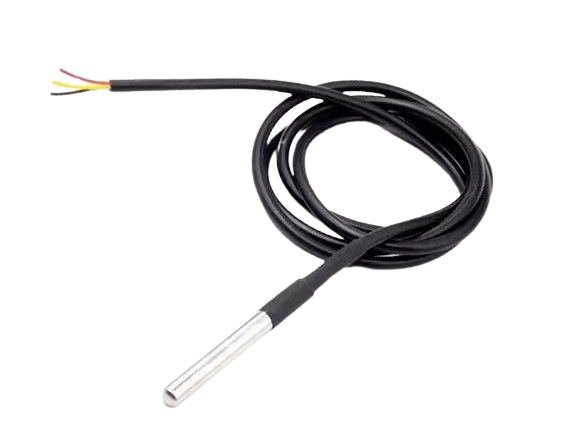
 Design with DS18B20 in Cirkit Designer
Design with DS18B20 in Cirkit DesignerIntroduction
The DS18B20 is a precision digital temperature sensor that provides 9-bit to 12-bit Celsius temperature measurements. It communicates over a 1-Wire bus that by design requires only one data line (and ground) for communication with a central microprocessor. It has an operating temperature range of -55°C to +125°C and is accurate to ±0.5°C in the range of -10°C to +85°C. Additionally, the DS18B20 can derive power directly from the data line ("parasite power"), eliminating the need for an external power supply.
Common applications of the DS18B20 include HVAC environmental controls, temperature monitoring systems inside buildings, equipment or machinery, and process monitoring and control systems.
Explore Projects Built with DS18B20
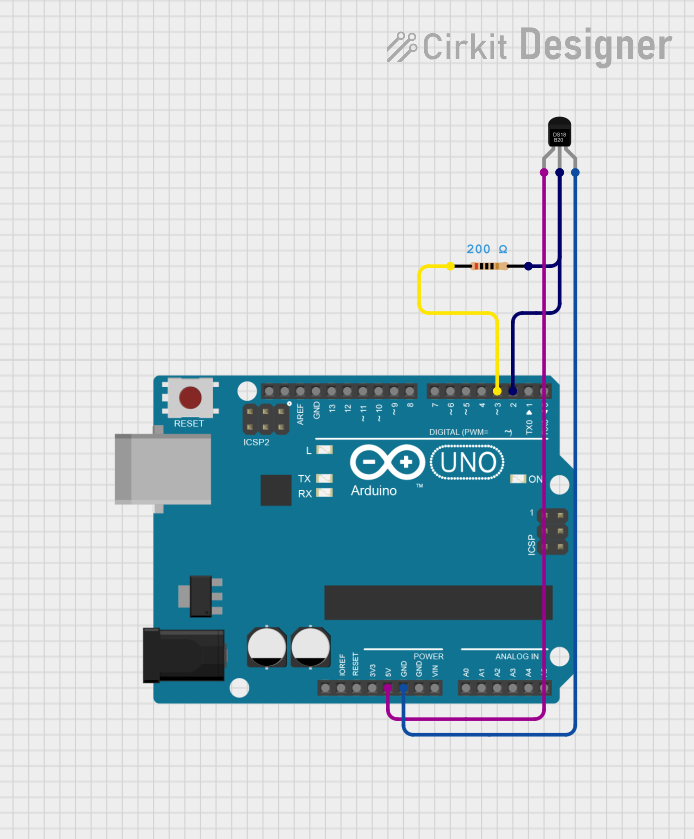
 Open Project in Cirkit Designer
Open Project in Cirkit Designer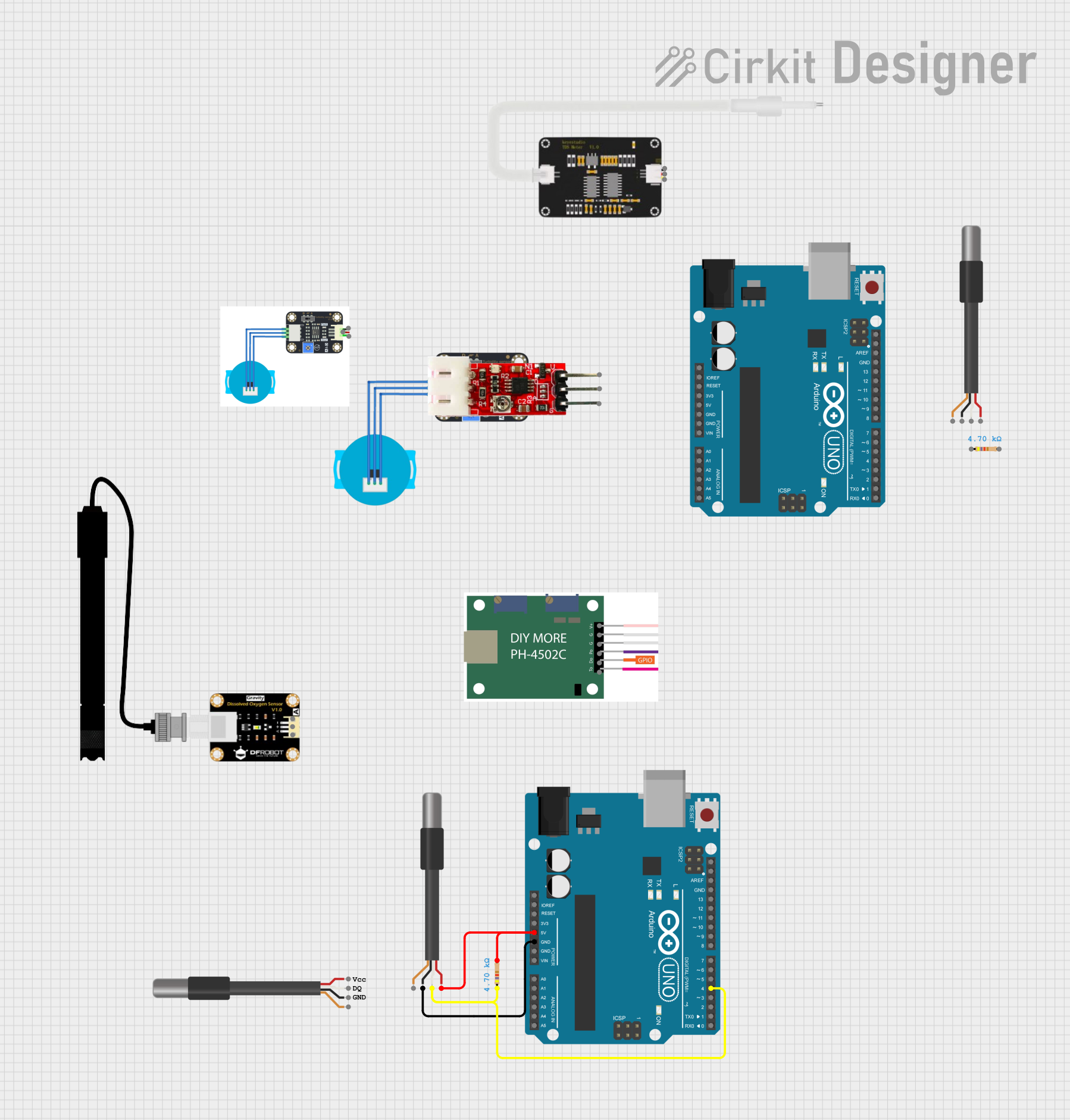
 Open Project in Cirkit Designer
Open Project in Cirkit Designer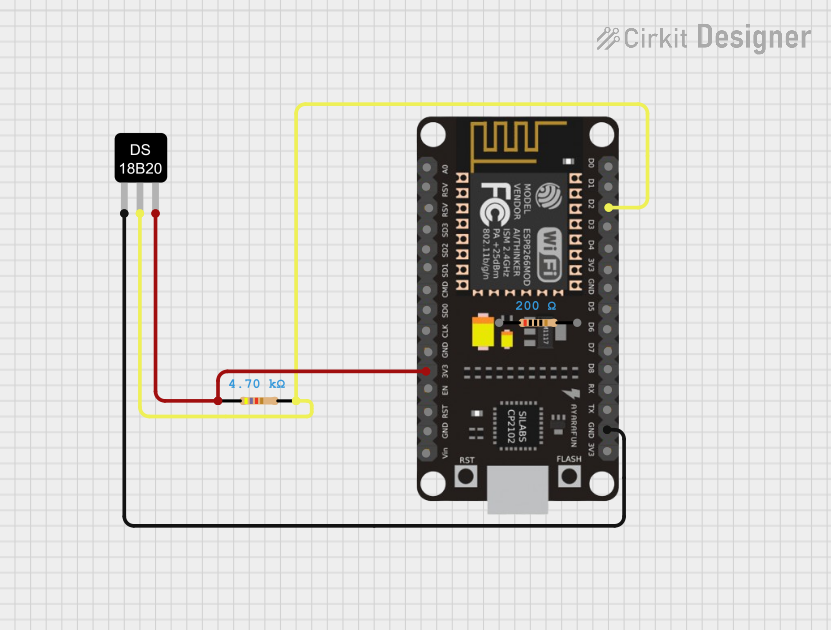
 Open Project in Cirkit Designer
Open Project in Cirkit Designer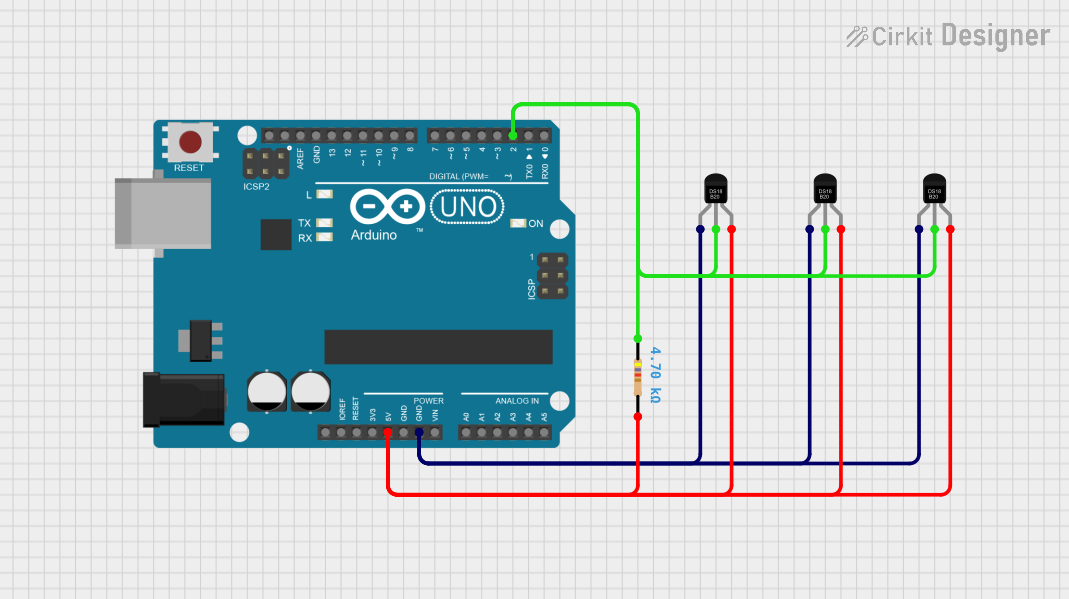
 Open Project in Cirkit Designer
Open Project in Cirkit DesignerExplore Projects Built with DS18B20

 Open Project in Cirkit Designer
Open Project in Cirkit Designer
 Open Project in Cirkit Designer
Open Project in Cirkit Designer
 Open Project in Cirkit Designer
Open Project in Cirkit Designer
 Open Project in Cirkit Designer
Open Project in Cirkit DesignerTechnical Specifications
Key Technical Details
- Supply Voltage (VDD): 3.0V to 5.5V
- Operating Temperature Range: -55°C to +125°C
- Accuracy: ±0.5°C from -10°C to +85°C
- Resolution: Selectable from 9 to 12 bits
- Unique 64-bit Serial Code: Stored in an onboard ROM
- Conversion Time: 750ms at 12-bit resolution
Pin Configuration and Descriptions
| Pin Number | Name | Description |
|---|---|---|
| 1 | GND | Ground |
| 2 | DQ | Data Line |
| 3 | VDD | Power Supply (3.0V to 5.5V) |
Usage Instructions
Connecting the DS18B20 to a Circuit
- Connect the GND pin to the ground of the power supply.
- Connect the VDD pin to the positive side of the power supply (3.0V to 5.5V).
- Connect the DQ pin to the GPIO pin on the microcontroller.
- A 4.7kΩ resistor is typically used as a pull-up on the DQ line to VDD.
Important Considerations and Best Practices
- Ensure that the power supply is within the specified range (3.0V to 5.5V).
- Use a pull-up resistor on the DQ line to prevent data corruption.
- For long wire runs or multiple sensors, consider using a lower value pull-up resistor.
- Avoid placing the sensor near heat-generating components to prevent false readings.
- When using parasite power, the VDD pin should be connected to ground.
Example Code for Arduino UNO
#include <OneWire.h>
#include <DallasTemperature.h>
// Data wire is connected to Arduino digital pin 2
#define ONE_WIRE_BUS 2
// Setup a oneWire instance to communicate with any OneWire device
OneWire oneWire(ONE_WIRE_BUS);
// Pass oneWire reference to DallasTemperature library
DallasTemperature sensors(&oneWire);
void setup() {
Serial.begin(9600);
sensors.begin(); // Start up the library
}
void loop() {
sensors.requestTemperatures(); // Send command to get temperatures
Serial.print("Temperature is: ");
Serial.print(sensors.getTempCByIndex(0)); // Get temperature in Celsius
Serial.println("°C");
delay(1000); // Wait 1 second before next reading
}
Troubleshooting and FAQs
Common Issues
- Temperature Readings Are Inaccurate:
- Ensure the sensor is not placed near heat sources.
- Check the pull-up resistor value; it may need adjustment.
- No Data or Communication Errors:
- Verify connections and ensure the pull-up resistor is in place.
- Check if the correct GPIO pin is defined in the code.
- Multiple Sensors Not Working:
- Ensure each sensor has a unique address.
- Use a star topology for wiring multiple sensors to reduce signal degradation.
Solutions and Tips for Troubleshooting
- Double-check wiring, especially the pull-up resistor on the DQ line.
- Use the
sensors.getAddress()function to verify the unique address of each DS18B20 sensor. - For long cable runs, use shielded cable to minimize interference.
- If using parasite power, ensure that the VDD pin is correctly connected to ground.
FAQs
Q: Can I connect multiple DS18B20 sensors to the same data line? A: Yes, each DS18B20 has a unique 64-bit serial code, which allows multiple sensors to function on the same 1-Wire bus.
Q: How do I set the resolution of the DS18B20?
A: The resolution can be set using the sensors.setResolution() function in the DallasTemperature library.
Q: What is the maximum cable length for the DS18B20? A: The maximum cable length depends on several factors, including the quality of the cable and the pull-up resistor value. Generally, lengths up to 100 meters are possible with careful design.
Q: Is it necessary to use an external power supply for the DS18B20? A: No, the DS18B20 can operate in parasite power mode, where it draws power from the data line. However, an external power supply can be used if preferred.